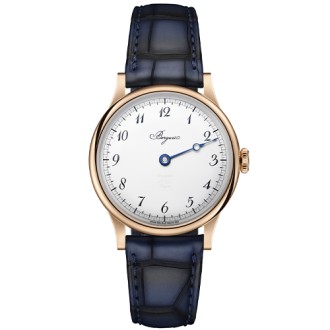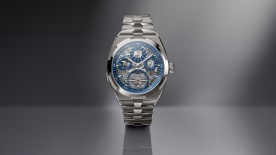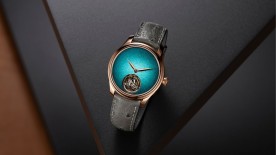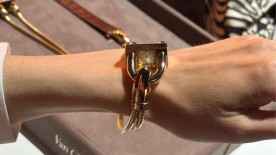High expectations can lead to disappointment. For its 250th anniversary, one might have expected Breguet to present a new type of tourbillon. A grand complication. New métiers d’art. Perhaps even a sympathique clock. Or maybe a bold move from new CEO Grégory Kissling to make his mark. But none of that happened.
Instead of these clichés, the manufacture took not one, but several risks. With the product itself, its finishing, materials, decoration, and historical references. By multiplying potential pitfalls, Breguet simultaneously increased its chances of going astray.
Breaking the glass ceiling
But the duo of Grégory Kissling and Emmanuel Breguet finally broke through the glass ceiling that had, until now, boxed the brand into a space too small for it: no, Breguet collectors are not unchangeable conservatives. It was a grave mistake to believe they were frozen in place. Kissling and Breguet understood this perfectly. In truth, Breguet's most knowledgeable fans are much like Abraham-Louis Breguet himself: curious, attuned to their era, drawn to innovation, and sensitive to boldness.

This shift in mindset is not just semantic. It’s a true paradigm shift. A horizon opens, full of new possibilities. Breguet once again allows itself to push its own limits, to surprise its audience, to step out of its comfort zone. And the Classique Souscription 2025 is the first embodiment of that.
A piece for seasoned collectors
The piece will likely shock casual fans of the brand. That’s a good thing: the Classique Souscription 2025 isn’t meant for them. It requires a deep knowledge of the Breguet universe to fully grasp, particularly the curious choice of making a watch so simple it has only one hand.

This piece avoids the easy trope of “returning to the roots of Abraham-Louis Breguet” or other heavy-handed marketing gimmicks. Instead, it targets a specific period in the life of the master watchmaker: thirty years, from 1795 to 1825. At that time, Breguet had just returned to Paris. He had fled the capital on August 12, 1793, forced to escape the Reign of Terror in his adopted country: “I was not myself, (...), I left behind my home and my workshops,” he would write about that fateful day.
Back to Paris
Two years later, in 1795, Breguet returned to Paris. The business needed a restart. Despite solid support from his second-in-command Thomas Boulanger, the Quai de l’Horloge workshop had slowed significantly. What to do?
Breguet understood the times had changed. Royal commissions for grand complications were no longer in demand—after all, many of those royal heads had rolled at Place de la Révolution (now Place de la Concorde). He needed to create a more widely accessible watch. He also needed immediate cash. Hence the idea of a subscription model: a watch partially paid for in advance, with the remainder due upon delivery.

Simple, yet uncompromising
Breguet designed the simplest watch possible, thus the single-hand display. The idea wasn’t new: in 1792, he had sold a single-hand watch to Talleyrand. In 1795, with the subscription watch, he took the concept further without compromising on quality or precision. He opted for large diameters (up to 61 mm) to make the minute scale legible enough for accuracy. The cases were gold. A few silver-and-gold models were made, but never one in silver only—likely not good enough for Breguet’s standards.
Lépine, a starting point
In this endeavor, Breguet was somewhat following in the footsteps of Jean-Antoine Lépine. The two were contemporaries. Lépine significantly advanced pocket watches with his now-famous movement design. In short, Lépine removed the bulky two-plate “sandwich” design in favor of a single plate and individual bridges for each component.
This made watches slimmer—something Breguet already mastered—but more importantly, much simpler. Breguet, however, would take Lépine’s approach to the next level in two ways.
First, aesthetically: the arrangement of the components was more harmonious. Then, practically: placing a large barrel at the center made energy transmission more efficient. The Souscription is an exercise in minimalism approaching perfection. And it wasn’t random: Breguet sold his first single-hand watch in 1792, returned to the concept in 1794 when business was at its lowest (only 14 simple watches were delivered that year—a sad record), refined the subscription concept in 1795, and came up with its final design in 1796. The project therefore took 5 years to complete.

A true product launch
But Breguet’s genius went far beyond just the design of the Souscription movement—though its elegance in simplicity should not be underestimated. He also orchestrated what we’d now call a full-on product launch, 250 years ahead of its time.
First, Breguet created a brochure to promote his subscription watch. That was unprecedented. The terms were clear: “The price of the watches will be 600 livres (...) ; a quarter of this sum shall be paid upon subscription; production will not be delayed, and delivery will follow the order of subscriptions.”
It was a success. For more than 25 years, Breguet sold between 40 and 70 per year. To understand that volume, consider that the Quai de l’Horloge workshop produced about 150 pieces annually on average. Subscription watches thus made up to 50% of Breguet’s output at their peak. That’s significant.
In total, about 700 Souscriptions were made in 30 years. Of that number, some were “montres à tact”—also single-hand, but with fundamentally different movements and construction. So the count of true Souscriptions is likely just over 600.

Horological theory
Directly stemming from this, Breguet developed a specific manufacturing method aimed at three goals: meeting demand, maintaining consistent quality, and ensuring permanent reparability.
For that last point, he applied to the Souscription the modular construction method he’d tested on some marine chronometers. Hence the introduction of a unique escapement—a “balance (...) held in a separate cage forming an independent system that can be removed to verify the full isolation of the regulator.” It’s essentially the invention of modular escapement—what we’d now call “plug & play”! Today, it’s the standard for almost all simple mechanical movements.
Still, it would be premature to talk of industrialization. Volumes were too low. The “watch industry” didn’t yet exist—it would arise in the U.S. mid-19th century. But Breguet conceptualized the two pillars of industrialization: division of labor and standardization. A visionary, he stated, “Nothing must be left to the judgment or memory of the worker for what has already been decided. He must have models for everything.”
Blueprint of a watch factory
We’re not yet at full industrialization—but already at the prototype of a watch factory, its essential precursor. Still, Breguet couldn’t resist “his old demons,” as Emmanuel Breguet notes with a smile. The master watchmaker gave in to creative temptation and designed many variations of his Souscription. It was ultimately made in many sizes—including a 40 mm version called the “medallion,” from which today’s piece directly descends—as well as variations in finishing and decoration.
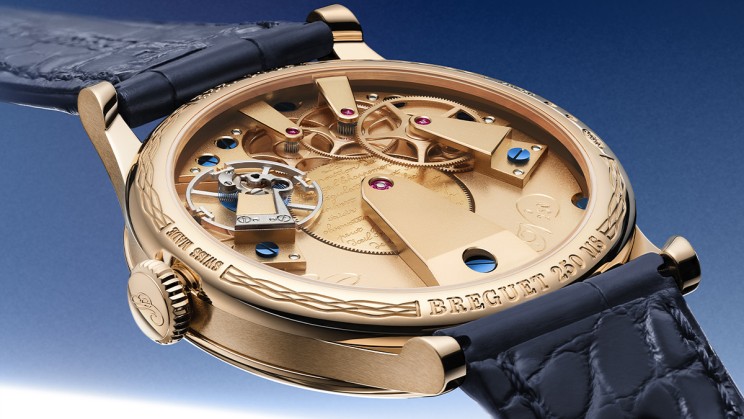
The Breguet Museum on Place Vendôme holds a dozen Souscription watches, of various eras, diameters (from 61 to 40 mm), and materials. This range reflects Abraham-Louis Breguet’s work in this category, though more pieces occasionally surface at auction. Collectors take note: under its apparent simplicity, this watch represents an entire chapter of horological history going under the hammer.


